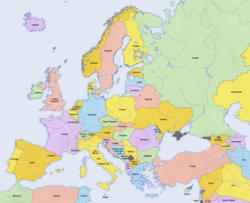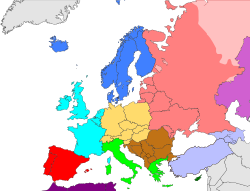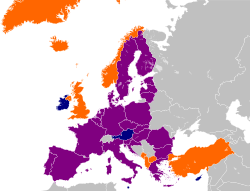
Main articles: Demographics of Europe, Ethnic groups in Europe, Immigration to Europe, Emigration from Europe, and Aging of Europe
Since the Renaissance, Europe has had a major influence in culture, economics and social movements in the world. The most significant inventions had their origins in the Western world, primarily Europe and the United States.[131] Some current and past issues in European demographics have included religious emigration, race relations, economic immigration, a declining birth rate and an aging population.
In some countries, such as Ireland and Poland, access to abortion is currently limited; in the past, such restrictions and also restrictions on artificial birth control were commonplace throughout Europe. Abortion remains illegal on the island of Malta where Catholicism is the state religion. Furthermore, three European countries (the Netherlands, Belgium, and Switzerland) and the Autonomous Community of Andalusia (Spain)[132][133] have allowed a limited form of voluntary euthanasia for some terminally ill people.
In 2005, the population of Europe was estimated to be 731 million according to the United Nations,[134] which is slightly more than one-ninth of the world's population. A century ago, Europe had nearly a quarter of the world's population.[135] The population of Europe has grown in the past century, but in other areas of the world (in particular Africa and Asia) the population has grown far more quickly.[134] Among the continents, Europe has a relatively high population density, second only to Asia. The most densely populated country in Europe is the Netherlands, ranking third in the world after Bangladesh and South Korea. Pan and Pfeil (2004) count 87 distinct "peoples of Europe", of which 33 form the majority population in at least one sovereign state, while the remaining 54 constitute ethnic minorities.[136]
According to UN population projection, Europe's population may fall to about 7% of world population by 2050, or 653 million people (medium variant, 556 to 777 million in low and high variants, respectively).[134] Within this context, significant disparities exist between regions in relation to fertility rates. The average number of children per female of child bearing age is 1.52.[137] According to some sources,[138] this rate is higher among Muslims in Europe. The UN predicts the steady population decline of vast areas of Eastern Europe.[139] Russia's population is declining by at least 700,000 people each year.[140] The country now has 13,000 uninhabited villages.[141]
Europe is home to the highest number of migrants of all global regions at 70.6 million people, the IOM's report said.[142] In 2005, the EU had an overall net gain from immigration of 1.8 million people, despite having one of the highest population densities in the world. This accounted for almost 85% of Europe's total population growth.[143] The European Union plans to open the job centres for legal migrant workers from Africa.[144][145] In 2008, 696,000 persons were given citizenship of an EU27 member state, a decrease from 707,000 the previous year. The largest groups that acquired citizenship of an EU member state were citizens of Morocco, Turkey, Ecuador, Algeria and Iraq.[146]
Emigration from Europe began with Spanish settlers in the 16th century, and French and English settlers in the 17th century.[147] But numbers remained relatively small until waves of mass emigration in the 19th century, when millions of poor families left Europe.[148]
Today, large populations of European descent are found on every continent. European ancestry predominates in North America, and to a lesser degree in South America (particularly in Argentina, Chile, Uruguay and Centro-Sul of Brazil). Also, Australia and New Zealand have large European derived populations. Africa has no countries with European-derived majorities, but there are significant minorities, such as theWhite South Africans. In Asia, European-derived populations (specifically Russians) predominate in Northern Asia.
Political geography
Main article: Politics of Europe
See also: Demographics of Europe, List of European countries by population, and List of sovereign states and dependent territories in Europe
According to different definitions, the territories may be subject to various categorisations. The 27 European Union member states are highly integrated economically and politically; the European Union itself forms part of the political geography of Europe. The table below shows the population and area figures for states in Europe. The socio-geographical data included are per sources in cross-referenced articles.
Name of country, withflag | Area (km²)  | Population (1 July 2002 est.)  | Population density (per km²)  | Capital |
|---|---|---|---|---|
| 28,748 | 3,600,523 | 125.2 | Tirana | |
| 468 | 68,403 | 146.2 | Andorra la Vella | |
| 29,800 | 3,229,900 | 101 | Yerevan | |
| 83,858 | 8,169,929 | 97.4 | Vienna | |
| 86,600 | 9,000,000 | 97 | Baku | |
| 207,600 | 10,335,382 | 49.8 | Minsk | |
| 30,510 | 10,274,595 | 336.8 | Brussels | |
| 51,129 | 4,448,500 | 77.5 | Sarajevo | |
| 110,910 | 7,621,337 | 68.7 | Sofia | |
| 56,542 | 4,437,460 | 77.7 | Zagreb | |
| 9,251 | 788,457 | 85 | Nicosia | |
| 78,866 | 10,256,760 | 130.1 | Prague | |
| 43,094 | 5,368,854 | 124.6 | Copenhagen | |
| 45,226 | 1,415,681 | 31.3 | Tallinn | |
| 336,593 | 5,157,537 | 15.3 | Helsinki | |
| 547,030 | 59,765,983 | 109.3 | Paris | |
| 69,700 | 4,661,473 | 64 | Tbilisi | |
| 357,021 | 83,251,851 | 233.2 | Berlin | |
| 131,940 | 10,645,343 | 80.7 | Athens | |
| 93,030 | 10,075,034 | 108.3 | Budapest | |
| 103,000 | 307,261 | 2.7 | Reykjavík | |
| 70,280 | 4,234,925 | 60.3 | Dublin | |
| 301,230 | 58,751,711 | 191.6 | Rome | |
| 2,724,900 | 15,217,711 | 5.6 | Astana | |
| 64,589 | 2,366,515 | 36.6 | Riga | |
| 160 | 32,842 | 205.3 | Vaduz | |
| 65,200 | 3,601,138 | 55.2 | Vilnius | |
| 2,586 | 448,569 | 173.5 | Luxembourg | |
| 25,713 | 2,054,800 | 81.1 | Skopje | |
| 316 | 397,499 | 1,257.9 | Valletta | |
| 33,843 | 4,434,547 | 131.0 | Chişinău | |
| 1.95 | 31,987 | 16,403.6 | Monaco | |
| 13,812 | 616,258 | 44.6 | Podgorica | |
| 41,526 | 16,318,199 | 393.0 | Amsterdam | |
| 324,220 | 4,525,116 | 14.0 | Oslo | |
| 312,685 | 38,625,478 | 123.5 | Warsaw | |
| 91,568 | 10,409,995 | 110.1 | Lisbon | |
| 238,391 | 21,698,181 | 91.0 | Bucharest | |
| 17,075,400 | 142,200,000 | 26.8 | Moscow | |
| 61 | 27,730 | 454.6 | San Marino | |
| 88,361 | 7,495,742 | 89.4 | Belgrade | |
| 48,845 | 5,422,366 | 111.0 | Bratislava | |
| 20,273 | 1,932,917 | 95.3 | Ljubljana | |
| 504,851 | 45,061,274 | 89.3 | Madrid | |
| 449,964 | 9,090,113 | 19.7 | Stockholm | |
| 41,290 | 7,507,000 | 176.8 | Bern | |
| 783,562 | 71,517,100 | 93 | Ankara | |
| 603,700 | 48,396,470 | 80.2 | Kiev | |
| 244,820 | 61,100,835 | 244.2 | London | |
| 0.44 | 900 | 2,045.5 | Vatican City | |
| Total | 10,180,000o[›] | 731,000,000o[›] | 70 |
Within the above-mentioned states are several regions, enjoying broad autonomy, as well as several de facto independent countries with limited international recognition or unrecognised. None of them are UN members:
Name of territory, withflag | Area (km²)  | Population (1 July 2002 est.)  | Population density (per km²)  | Capital |
|---|---|---|---|---|
| 8,432 | 216,000 | 29 | Sukhumi | |
| 1,552 | 26,008 | 16.8 | Mariehamn | |
| 1,399 | 46,011 | 32.9 | Tórshavn | |
| 5.9 | 27,714 | 4,697.3 | Gibraltar | |
| 78 | 64,587 | 828.0 | St. Peter Port | |
| 572 | 73,873 | 129.1 | Douglas | |
| 116 | 89,775 | 773.9 | Saint Helier | |
| 10,887 | [151] 1,804,838 | 220 | Pristina | |
| 11,458 | 138,800 | 12 | Stepanakert | |
| 3,355 | 265,100 | 78 | Nicosia | |
| 3,900 | 70,000 | 18 | Tskhinvali | |
Mayen Islands (Norway) | 62,049 | 2,868 | 0.046 | Longyearbyen |
| 4,163 | 537,000 | 133 | Tiraspol |








No comments:
Post a Comment